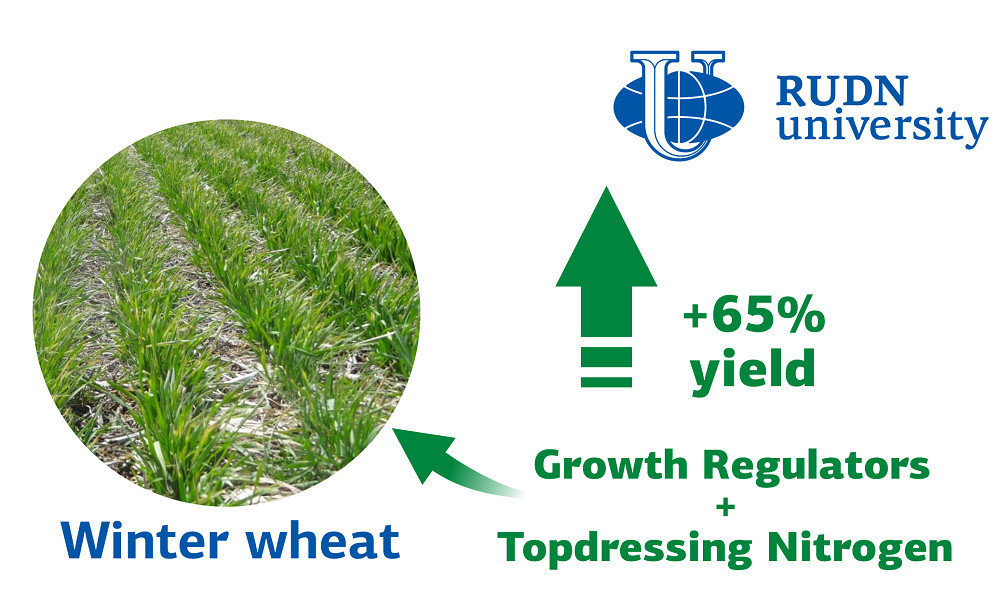RUDN University agronomists increased wheat yield by 65%

Wheat is the most demanding grain crop. For a good harvest, you need a large amount of nitrogen. However, excessive fertilizer, on the contrary, spoils the soil and reduces the yield. To solve this problem, a precisely balanced amount of fertilizer is needed. RUDN University agronomists suggested using nitrogen in combination with plant growth regulators.
“Among grain crops, winter wheat can be considered one of the most demanding on nitrogen. It is one of the main elements, it plays a key role in the development of soil cover, plant nutrition and soil fertility. To increase the yield of winter wheat grain, fertilizers must be applied. However, the irrational use of fertilizers leads to serious environmental problems and reduced profits for farmers. To avoid this, you need an effective ratio of basic and top dressing nitrogen and a combination with growth regulators. For this, it is necessary to better study the effect of nitrogenous fertilizers and growth regulators,” Meisam Zargar, Candidate of Agricultural Sciences, Associate Professor of the Agrobiotechnological Department of the Peoples’ Friendship University of Russia.
The field experiment lasted three years. The effect of top dressing was tested on the example of dark chestnut soil in the Rostov region (Russia), where winter wheat grew. RUDN University agronomists tested three approaches — with single, double and triple top dressing in the amount of 32 kilograms of nitrogen per hectare. In addition to nitrogen, the soil was treated with one of the growth regulators — Zircon, Albit or Silk.
The highest average yield for three years was produced by wheat, which was fertilized three times with nitrogen and Albit — 5.34 tons per hectare. In 2020, the harvest was especially high due to good weather conditions and reached 6.27 tons per hectare. For comparison: unprocessed wheat yields an average of 3.79 tons per hectare — 65% less. Moreover, the wheat fertilized in this way gave grain with a high gluten content — more than 28%. Such grain is suitable for the production of premium flour.
“Triple fertilizing with nitrogen plus the use of Albit turned out to be the best option for increasing the yield and quality of winter wheat grain,” Meisam Zargar, Candidate of Agricultural Sciences, Associate Professor of the Agrobiotechnological Department of RUDN University.
The results are published in the journal Agriculture.
RUDN summarized the results of the scientific competition "Project Start: work of the science club ". Students of the Faculty of Physics, Mathematics and Natural Sciences have created a project for a managed queuing system using a neural network to redistribute resources between 5G segments. How to increase flexibility, make the network fast and inexpensive and reach more users — tell Gebrial Ibram Esam Zekri ("Fundamental Computer Science and Information Technology", Master's degree, II course) and Ksenia Leontieva ("Applied Mathematics and Computer Science", Master's degree, I course).
The National Demographic Report, 2023 Demographic Well-Being of Russian Regions (hereinafter - the National Demographic Report) was prepared by the scientific team of the Institute of Demographic Studies of the Federal Research Center of the Russian Academy of Sciences, the Vologda Scientific Center of the Russian Academy of Sciences, Peoples' Friendship University of Russia, the Center for Family and Demography of the Academy of Sciences of the Republic of Tatarstan, as well as with the participation of leading scientists from the Republic of Bashkortostan, Stavropol Krai, Volgograd, Ivanovo, Kaliningrad, Nizhny Novgorod, Sverdlovsk Oblasts and Khanty-Mansi Autonomous Okrug–Yugra.
RUDN summarized the results of the scientific competition "Project Start: work of the science club ". Students of the Faculty of Physics, Mathematics and Natural Sciences have created a project for a managed queuing system using a neural network to redistribute resources between 5G segments. How to increase flexibility, make the network fast and inexpensive and reach more users — tell Gebrial Ibram Esam Zekri ("Fundamental Computer Science and Information Technology", Master's degree, II course) and Ksenia Leontieva ("Applied Mathematics and Computer Science", Master's degree, I course).
What is your first association with the word “laboratory”? Flasks and beakers? Microscopes and centrifuges? Yes, many of us would answer the same way.
The National Demographic Report, 2023 Demographic Well-Being of Russian Regions (hereinafter - the National Demographic Report) was prepared by the scientific team of the Institute of Demographic Studies of the Federal Research Center of the Russian Academy of Sciences, the Vologda Scientific Center of the Russian Academy of Sciences, Peoples' Friendship University of Russia, the Center for Family and Demography of the Academy of Sciences of the Republic of Tatarstan, as well as with the participation of leading scientists from the Republic of Bashkortostan, Stavropol Krai, Volgograd, Ivanovo, Kaliningrad, Nizhny Novgorod, Sverdlovsk Oblasts and Khanty-Mansi Autonomous Okrug–Yugra.